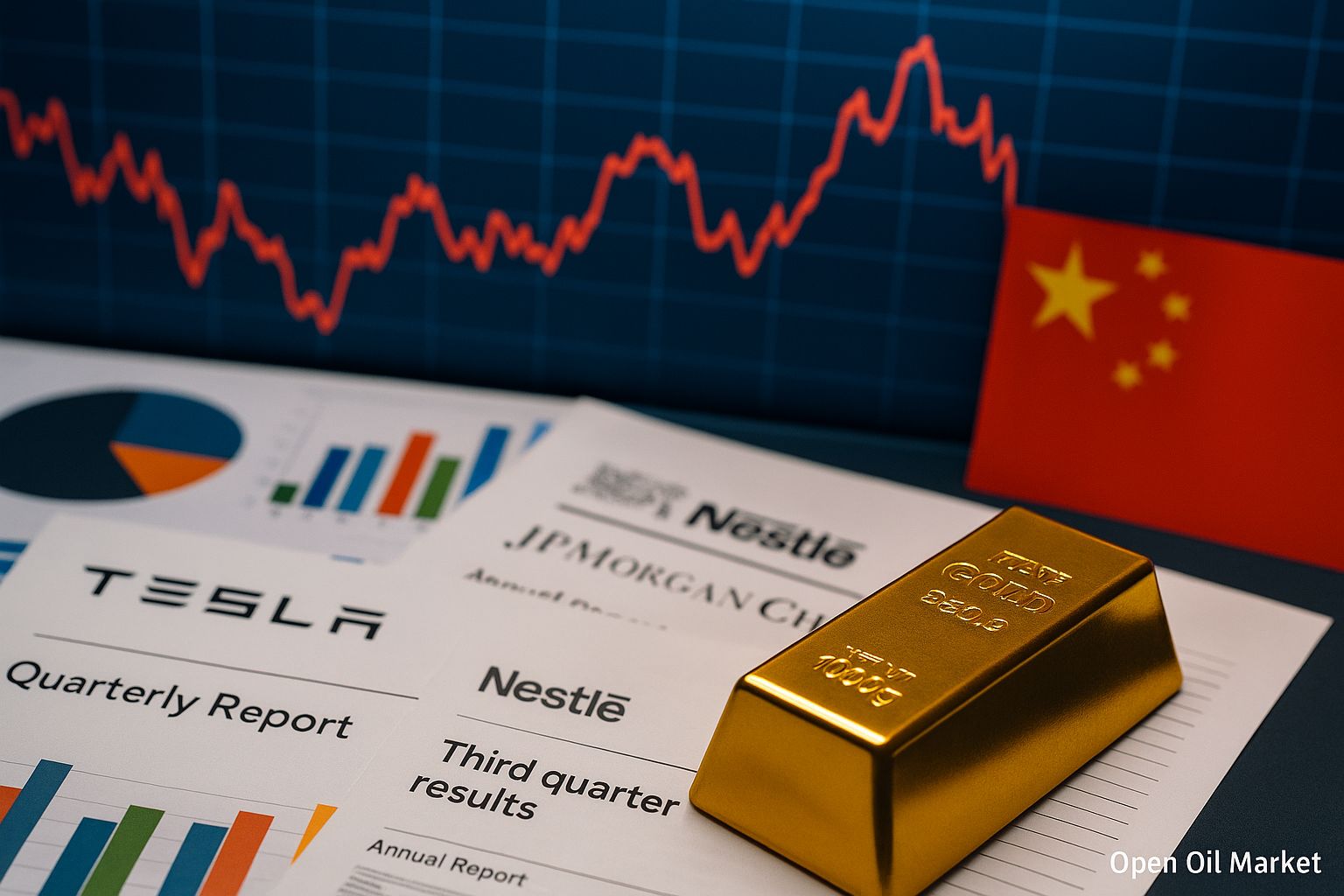
Detailed Overview of Economic Events and Corporate Reports on October 19, 2025: The People's Bank of China's LPR Decision, Outcomes of IMF and World Bank Meetings, Commodity Market Dynamics, and Preparing Investors for the New Week.
Sunday, October 19, promises a relatively calm agenda in financial markets. However, investors should pay attention to the concluding cycle of the annual IMF and World Bank meetings in Washington, where the prospects for the global economy and financial stability are being discussed. In the Asia region, the focus is on the People's Bank of China's interest rate decision, which may signal further monetary policy directions from Beijing amid a slowdown in the Chinese economy. The corporate sector is taking a breather: during the peak reporting season for major companies, this Sunday is relatively quiet in terms of announcements, and market participants are preparing for a new week full of events. The overall tone is set by macroeconomic factors and investor expectations ahead of upcoming data and reports.
Macroeconomic Calendar (MSK)
- All day – Washington: final day of the annual IMF and World Bank meetings.
- 1:15 PM – China: People's Bank of China's lending rates decision (LPR for 1 and 5 years) for October.
Asia: PBOC Decision and Signals from China
- The People's Bank of China is expected to maintain its benchmark lending rates (LPR) at the current level (1-year rate around 3.45%) due to persistent deflationary pressure and weak domestic demand. Beijing is trying to support the economy with stimulus measures; however, it is not taking drastic monetary steps to avoid capital outflows and pressure on the yuan.
- Investors will be monitoring the regulator's rhetoric: any hints from the PBOC regarding future policy easing or additional stimuli could bolster sentiment in Asian markets. Conversely, cautious comments without new economic support measures would confirm a cautious outlook and could heighten concerns about China's growth rates.
- It is worth noting that early in the new week, China will release important macro data (including GDP for Q3 and statistics on industrial output and consumption). Together with the interest rate decision, these indicators will provide a fuller picture of the health of the world's second-largest economy, determining further risk appetite in the emerging markets segment.
Global Economy: Outcomes of IMF Meetings
- At the annual IMF and World Bank meetings, the main topic was the prospects of the global economy in the context of post-pandemic recovery and geopolitical risks. According to the IMF's latest estimates, global growth in 2025 is expected to be around 3% – a relatively moderate pace reflecting a slowdown compared to last year. For developed economies, the forecast is only ~1.5–1.6% in 2025, while emerging markets are expected to grow at around 4% (largely driven by Asia).
- The IMF notes that inflation worldwide is gradually declining but remains above target levels in many countries. Fund representatives urged central banks to remain vigilant: a premature easing of monetary policy could reignite inflationary pressures. Simultaneously, governments are recommended to flexibly utilize budget measures to support vulnerable populations amidst rising living costs while avoiding excessive public debt accumulation.
- A particular focus at the meetings was on the challenges facing developing countries. IMF leadership emphasized the need for debt restructuring for the most burdened countries and called for increased support from developed economies and international organizations. Discussions also covered reforms to the international financial architecture: from expanding development fund resources to adapting the activities of the IMF and the World Bank to new challenges (climate risks, digital economy). The final statements underscore the importance of coordinated policies to ensure sustainable and inclusive global economic growth.
Energy and Commodity Markets
- Oil: Oil prices continue to decline. The WTI benchmark fell below $60 per barrel – the first time since the beginning of summer – amid signs of de-escalation in geopolitical tensions in the Middle East and expectations of increased supply. Investors note that the growing likelihood of a ceasefire in the protracted conflict reduces the risks of oil supply disruptions, which is immediately reflected in prices. Additional pressure on energy markets is stemming from concerns regarding a slowdown in the global economy, arising after cautious IMF forecasts: weaker demand may restrict the potential for rising oil prices.
- Precious Metals: Gold and silver are displaying opposite dynamics – both metals have significantly appreciated, confirming high demand for safe-haven assets. The price of gold has reached a historic high, exceeding $4300 per ounce, while silver trades above $54 per ounce. The driver of this growth is the investors' desire for a “safe haven” amid ongoing macroeconomic uncertainty and local financial upheavals (in particular, recent turmoil around regional banks in the US). Additionally, expectations of more accommodative Fed policy in the future (due to signals of slowing economic growth and declining inflation) support the appeal of precious metals, as lower rates increase the value of non-yielding assets.
- Other Commodities: Industrial metals are trading without a unified trend. On one hand, copper and several base metals are under pressure due to concerns about demand in China – a major commodity consumer. On the other hand, any hints of incentives from the PBOC or improvements in US-China trade relations could boost prices. In agricultural markets, the situation is stable: prices for grains and oilseeds are holding within ranges following the publication of the latest WASDE report, and market participants are awaiting new signals regarding demand-supply balance.
Corporate Reports: Asia and Russia
- India: In the absence of US and European reports, attention shifts to emerging markets. Major Indian bank RBL Bank published its financial results for Q2 of the 2025 fiscal year (ending in September). RBL's net profit decreased by approximately 20% year-on-year, to around ₹178 crore (≈ $180 million), with a slight decline in interest income. Nonetheless, investors reacted positively to news of strategic changes: the bank confirmed the attraction of significant investment from Middle Eastern partner Emirates NBD, which plans to acquire a substantial stake (up to a controlling share) in RBL's capital. This influx of foreign capital supports confidence in the Indian banking sector and provides RBL with resources for further growth despite a temporary profit decline.
- Russia: The Russian market is closed on Sunday, and no significant corporate announcements are scheduled for this date. Most companies on the Moscow Exchange are preparing to release results for the third quarter from late October to early November. Investors are observing preliminary operational data from individual issuers: in particular, the oil and gas sector and metallurgists periodically publish quarterly reports on production and output. So far, no significant surprises have been noted. Major players (Sberbank, Gazprom, Rosneft, etc.) will traditionally release their reports closer to November. Individual corporate news may come from second-tier companies – for instance, announcements of dividends or completion of deals – but their influence on the overall market is limited.
- Middle East: In the Gulf countries, where the workweek begins on Sunday, the corporate reporting season is also gaining momentum. No financial results from the region's largest state-owned companies are expected on October 19; however, the background for investors is shaped by oil prices and local news. A decline in oil prices could reflect on the shares of Middle Eastern energy companies during Sunday trading. Overall, Gulf stock indices are entering the new week with cautious optimism, relying on consistently high liquidity levels and investment inflows into oil and gas projects.
Corporate Reports: US and Europe
- United States: The American market traditionally does not operate on Sundays, and no major corporate reports from the S&P 500 are released on this date. After a turbulent start to the reporting season (with many banks and first tech firms already reporting), Wall Street is taking a breather. However, starting Monday, investors can expect a new wave of third-quarter results. High-tech and medical companies will be in focus: for example, on October 20, Intuitive Surgical – a manufacturer of robotic surgical systems – will present its quarterly results, which will clarify the state of demand in the med-tech sector. Additionally, at the week’s outset, several industrial corporations and retailers are expected to report, which will provide insights into demand resilience in the US economy. Careful analysis of margin metrics, management forecasts, and revenue trends by segments will help investors adjust their strategies ahead of the key tech giants’ reports later in the week.
- Europe: In Europe, October 19 is a public holiday for exchanges; thus, no large releases from Euro Stoxx 50 companies are scheduled. Nevertheless, at the very beginning of the new week, a series of publications from European leaders in various sectors will commence. Some industrial and automotive companies are expected to report on sales for the past quarter; for example, on Monday, investors will look closely at data from Forvia (Faurecia) and other automakers that will unveil revenue for Q3, providing insights into global auto demand. The European financial sector is also entering its reporting season: later in the week, major banks and insurers will present their results. The focus of EU markets will be on how inflation and rising rates have affected banks' profitability and consumer activity. Positive surprises from European companies could support the recovery of the Euro Stoxx 50 index, while disappointments may add volatility to specific stocks and sectors.
Other Regions and Indices: Euro Stoxx 50, Nikkei 225, MOEX
- Euro Stoxx 50: European markets are taking a holiday in anticipation of new data and reports. On Sunday, there are no external triggers for European indices to move, so the Euro Stoxx 50 will enter Monday's trading under the influence of the global news backdrop. Investors in Europe are evaluating the outcomes of the IMF meetings (especially regarding forecasts for the Eurozone) and preparing for important macro indicators to be released later in the week. Signs of further declining inflation in the EU and stable corporate reports may support the index, while any negative surprises (e.g., weak data from China or unexpected corporate issues) could hinder the recovery of the European market.
- Nikkei 225 (Japan): The Japanese stock market is traditionally closed on Sundays. On Monday, the Tokyo Stock Exchange will open, responding to several factors: firstly, reactions to Chinese decisions and global news from the weekend, and secondly, internal statistical data. At the start of the week, fresh macro data is expected in Japan, including inflation figures for September. If these show an uptick in core inflation, this may strengthen expectations for a firmer policy from the Bank of Japan and, accordingly, affect market participants' sentiments. However, overall, the Nikkei 225 maintains the upward trend of recent months thanks to a strong earnings season: many Japanese corporations have already reported better than expected results for the prior quarter, with investors hoping for continued positive corporate profit dynamics.
- MOEX (Moscow Exchange): The Russian MOEX index does not conduct trades on Sundays. Upon opening on Monday, the domestic stock market will be guided by a combination of external and internal factors. On one hand, an improving environment in global capital markets (e.g., rising metal prices or progress in resolving global conflicts) could lift the index. On the other hand, a fall in oil prices below levels comfortable for the Russian budget could dampen investor enthusiasm, especially in the oil and gas sector. Additional guidance will come from expectations regarding local statistics: data on industrial production and a Bank of Russia meeting are scheduled for the new week. Overall, the MOEX enters the final quarter of the year on a relatively solid foundation, but the volatility of the external environment requires market participants to pay close attention to developments outside of Russia.
Summary for the Day: What Investors Should Focus On
- China and Monetary Policy: The People's Bank of China's decision on the LPR will be a key indicator of Beijing's sentiment. Investors should watch for any signals of policy easing – an unexpected rate cut would support stocks and currencies in emerging markets in Asia, while maintaining the status quo amid weak economic data would increase deflation concerns. The reaction of the Chinese yuan and Hong Kong market on Monday morning will show how the market has perceived the PBOC's actions.
- IMF Communications and Global Risk Appetite: The final statements from the IMF at the conclusion of the meetings will provide direction for global risk appetite. If the IMF emphasizes the resilience of the global economy and progress in reducing inflation, this could support stock indices worldwide. However, mentions of risks (such as high EM debt, geopolitical issues, or financial instability) will remind investors of the need for caution. Particular attention should be paid to the IMF’s forecasts for the US, EU, and China: these will shape expectations regarding corporate profits and interest rates.
- Oil Prices and Commodities: The decline in oil prices to several-month lows is significant for energy-intensive industries and exporting countries. Investors holding positions in oil and gas companies or currencies of resource-rich countries should assess whether the price drop is temporary (due to certain news) or reflects a deeper deterioration in the demand-supply balance. Simultaneously, the record rise in gold prices signals increased demand for safe-haven assets – this could herald increased volatility if economic data fall short of expectations.
- Corporate Pause Before the Storm: The quiet in the corporate calendar on Sunday offers a good opportunity for investors to reassess their strategies ahead of a series of important reports in the new week. It’s wise to identify in advance key companies whose results may significantly impact the portfolio. In the US, this will include the technology and consumer sectors (several companies from NASDAQ and S&P 500 are set to report in the early days of the week); in Europe, the focus will be on the industrial and finance sectors. Prepared scenarios (beat/meet/miss) for key reports and the placement of stop-losses will equip investors to meet the new wave of corporate news fully prepared.
- Balancing Risks and Hedging: Despite the relatively calm backdrop of Sunday, overall market uncertainty remains. Investors are advised to use the downtime to check their risk balance in their portfolios. Geopolitical news can emerge suddenly even on weekends, hence the presence of safe-haven assets (such as gold or hedging instruments against sharp index movements) remains pertinent. A clear understanding of key support and resistance levels for major assets and currencies will allow quick reactions to any unforeseen events at the start of the new trading week.




